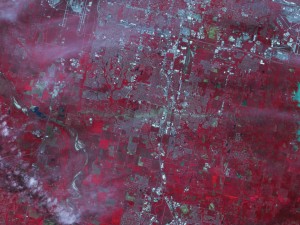TerraGo has provided one of the easier to use geospatial toolsets that has seen widespread adoption, particularly in the field and for the warfighter with their GeoPDF and mobile tools. Recently there have been some leadership changes, and a move of the company’s headquarters. Sensors & Systems (S&S) editor Matt Ball spoke with Chris Broderick, the company’s new CEO, about the tools, the geospatial market and the focus on new opportunities that is underway.
S & S You have been at TerraGo for less than a month at this point, and the company headquarters are moving to the Washington, D.C. area. What has led to that change?
BRODERICK Our board of directors made the location decision because TerraGo’s business today is predominantly defined by federal government customers, and they like to be in close proximity to their vendors. So, having a location that helps us better serve and collaborate with our largest customer base makes a lot of sense for the company.
S & S You come into the geospatial community with a background in software and solutions, but not necessarily geospatial exposure. Is that right?
BRODERICK I think that’s exactly right. I have no deep vocational experience in the GIS space. But I’ve spent the majority of my career in the software space, working with both small innovators and larger software companies. I spent quite a bit of time with Computer Associates, with their storage management business. I went on to work with a small company that was focused on high-end security solutions for the federal government (the Public Key Infrastructure space). Then, most recently, I was with a firm that was in the mobility space.
S & S You’ve moved into the analysis of information, and the ability to ingest large amounts of data with the acquisition of Geosemble. Is the idea to better inform the context of location?
BRODERICK If you look at the way that people have come to appreciate access to information, a lot has changed recently. If you think about the ways that individuals interact with their systems, they want simplicity and are comfortable interacting with disparate data sources. As a consumer, we don’t care where information comes from; we just want it aggregated in a way that makes sense. The idea of taking portable geospatial information coupled with the ability to overlay other types of information in the context of location is powerful. Those sources are social media, public media, government information, and others, all being presented in context in an area of interest.
S & S With the data management and mobility experience, there seem to be elements that mesh with TerraGo’s offerings. I think of TerraGo’s primary benefit as being a mobile ease of use tool.
BRODERICK I think that’s right. If you look at the core of what TerraGo does really well today, it provides the ability to consume and interact with geospatial information, and the way that we do it has a high degree of portability. We also operate in places where devices have low bandwidth or in areas where communication isn’t possible. That portability of distribution of information is really the secret sauce for TerraGo. We see an opportunity to expand this idea to more devices and peripherals, and to make the information easier to interact with. Both the public and private sectors have become comfortable with this idea of portability that the company has already perfected.
S & S You’ve come to the company at an interesting time, with a nice foundation of recently raised funds, but also at a time when the government is cutting back. What has the impact of the sequestration been, and is there a logical response to it?
BRODERICK The biggest impact that the sequestration has is the uncertainty with our biggest buyer. The sequestration creates a lot of confusion with our customers. They don’t know what it means, how long it will last, and it creates paralysis where they are unable to make commitments into the future. The window of thinking has narrowed down to the now.
On the other side, you can say that the government does not appear to be willing to pare back the tools that support the warfighter and citizens that are abroad. Where we fit, related to the systems and the way that government customers use our software, is high in that priority stack. We intend to identify and establish commercial markets that can lessen our dependence on the government. We have had some success in the oil and gas and utility business. We see other repeatable markets, similar to the needs of the government, to provide this portable ability to interact with information in the context of their location.
S & S I know that you have a Software Developer Kit (SDK) and other offerings that are geared toward developers or enterprise customers to customize the offering. Would there be solutions tailored toward specific markets that you develop yourselves or is a third party doing that kind of thing?
BRODERICK The trick of any successful software company is to be able to scale by solving problems that large numbers of organizations face. What we need are products and solutions that can be geared to a large number of vertical markets while maintaining a core set of intellectual property along the way.
We don’t want to create a bunch of one-off solutions that go after narrow markets. That’s really why the SDK is important for us, because there are other companies that have the expertise to service specific verticals. It’s ideal for us to embed our technology into a broader technology or service that they provide. We do that today, and we’ll continue to do that in the future.
S & S There are so many potentially disruptive technologies for geospatial businesses that are on the cusp of entering more mainstream use, such as wearable computers (GoogleGlass)and widespread use of UAVs,among others. Are these opportunities, but also a reason to tread cautiously on where you place your research and development dollars?
BRODERICK What I think is happening in the GIS space is that innovation hasn’t kept pace with other industries and other verticals, and it’s why I like the opportunity so much. There are lots of opportunities to increase the pace of innovation, the simplicity of experience for the end user, and create markets that may not exist today.
There are several areas of potential disruption that we’re focused on. We’re in the early days of thinking about the future, and prioritizing the investments that we’re going to make. We’re considering several of these disruptions, and will need to circle back with our plans when our ideas are more fully baked.
S & S Are you comfortable discussing some of the areas where geospatial technology hasn’t been as innovative as other verticals?
BRODERICK What has become obvious in the short time that I’ve been immersed in this space is that there’s an overall move toward the democratization of GIS. It’s something that I’ve heard; this idea of democratization seems to be real. What I mean by democratization is that the creation of geospatial content and the access to geospatial con- tent has historically been in the hands of the few and the highly specialized. A highly specialized skill set of a few are really the ones who have been responsible for the creation of geospatial information that gets distributed to consumers of geospatial information. There seems to be a strong desire amongst the organizations that create geospatial content to democratize this creation with simpler tools that can be used by individuals with far less skills to create and package geospatial information and make it valuable to their constituents. What that means for the technology is really disruptive. You have a core set of tools that are being pressured to simplify the experience and open them up, which is creating an opportunity for new players to fill that gap.
S&S TerraGo is interesting, because you’ve been both a long tail company in terms of getting this data into the hands of a lot of people, as well as selling to just a few large organizations that have a lot of people. Is part of the plan going forward to get in front of many more companies or to find more large organizations with a large workforce with similar needs to your existing large customers?
BRODERICK I would say that the business model for TerraGo has been to focus on the individuals within organizations that make maps. The individuals and organizations that make maps have been public sector organizations or near public sector. I think that’s changing a lot, and where we want to focus is on the consumers of geospatial information. If you look across the space, and look across what is available in the hands of the consumer of geospatial information and services, it’s a relatively underserved market.



